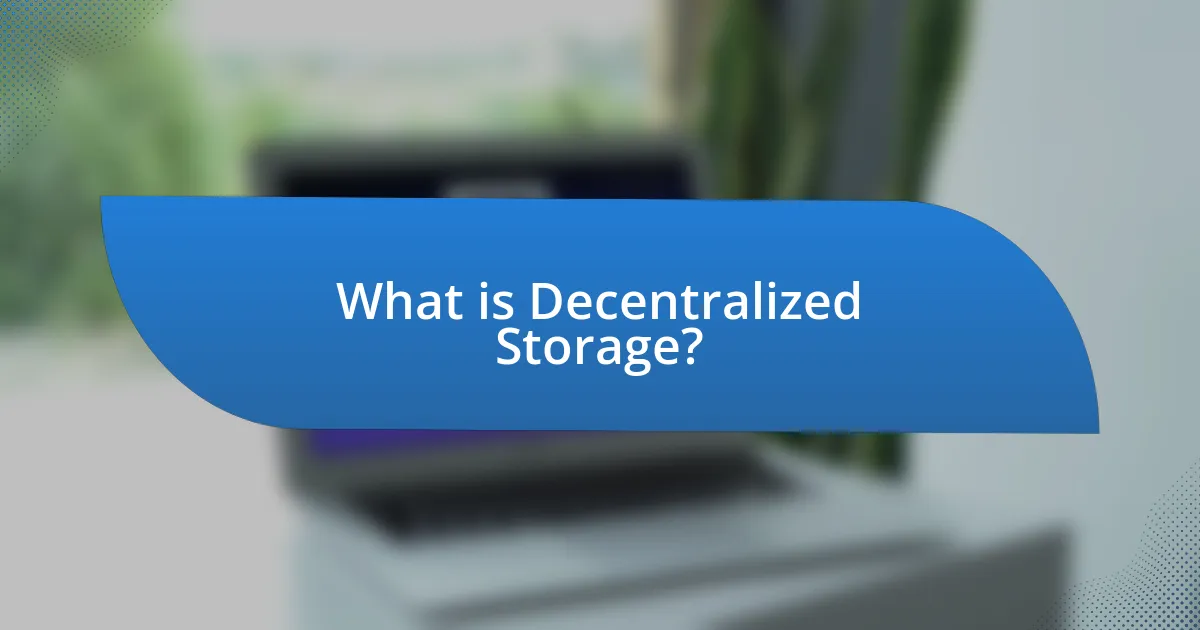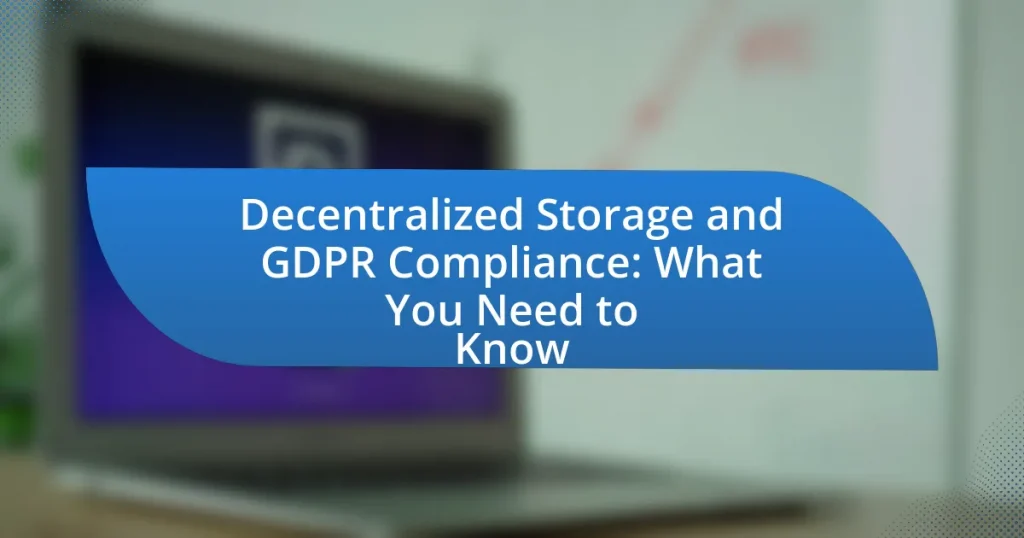Decentralized storage is a data storage method that distributes information across multiple nodes, enhancing security and availability compared to traditional centralized systems. This article explores the differences between decentralized and traditional storage solutions, the technologies that support decentralized storage, and its benefits, including improved data security and cost efficiency. It also examines the implications of the General Data Protection Regulation (GDPR) on data storage practices, highlighting compliance challenges and best practices for organizations utilizing decentralized storage. Key topics include data subject rights, encryption, access controls, and the importance of ongoing audits to ensure compliance with GDPR requirements.

What is Decentralized Storage?
Decentralized storage is a method of data storage that distributes data across multiple locations or nodes rather than relying on a single centralized server. This approach enhances data security and availability, as it reduces the risk of data loss or breaches associated with centralized systems. For instance, platforms like IPFS (InterPlanetary File System) utilize decentralized storage to ensure that files are stored across a network of computers, making them more resilient to failures and censorship.
How does Decentralized Storage differ from traditional storage solutions?
Decentralized storage differs from traditional storage solutions primarily in its architecture and data management approach. Traditional storage relies on centralized servers, which creates a single point of failure and potential vulnerabilities, while decentralized storage distributes data across multiple nodes, enhancing security and resilience. For instance, in decentralized systems like IPFS (InterPlanetary File System), data is stored in a peer-to-peer network, making it less susceptible to data breaches and outages compared to centralized cloud services, which have experienced significant security incidents. This fundamental difference in structure not only improves data integrity but also aligns with principles of data sovereignty and user control, which are increasingly important in regulatory frameworks like GDPR.
What technologies underpin Decentralized Storage?
Decentralized storage is primarily underpinned by blockchain technology, peer-to-peer networking, and cryptographic protocols. Blockchain technology ensures data integrity and transparency by recording transactions in a distributed ledger, while peer-to-peer networking allows users to share and store data directly without a central authority. Cryptographic protocols enhance security by encrypting data, ensuring that only authorized users can access it. These technologies collectively enable a robust and secure decentralized storage system, facilitating data management in compliance with regulations like GDPR.
How does data distribution work in Decentralized Storage?
Data distribution in decentralized storage involves the fragmentation of data into smaller pieces, which are then distributed across multiple nodes in a network. This method enhances data redundancy and availability, as no single point of failure exists; if one node goes offline, the data remains accessible from other nodes. For instance, protocols like IPFS (InterPlanetary File System) utilize content addressing to ensure that data can be retrieved from any node that holds a copy, thereby optimizing retrieval efficiency and resilience. This approach not only secures data against loss but also aligns with GDPR compliance by allowing users to control their data across various locations without relying on a central authority.
What are the key benefits of Decentralized Storage?
Decentralized storage offers enhanced security, improved data availability, and increased privacy. By distributing data across multiple nodes, it reduces the risk of data breaches and single points of failure, as evidenced by the fact that decentralized systems like IPFS and Filecoin have shown resilience against attacks compared to centralized counterparts. Additionally, decentralized storage allows users to maintain control over their data, aligning with GDPR principles of data ownership and consent, which is crucial for compliance in the European Union.
How does Decentralized Storage enhance data security?
Decentralized storage enhances data security by distributing data across multiple nodes rather than storing it in a single location. This distribution minimizes the risk of data breaches, as compromising one node does not grant access to the entire dataset. Additionally, decentralized storage often employs encryption techniques, ensuring that even if data is intercepted, it remains unreadable without the proper decryption keys. Research indicates that decentralized systems can reduce the likelihood of unauthorized access by up to 80% compared to traditional centralized storage solutions, thereby significantly improving overall data security.
What cost advantages does Decentralized Storage offer?
Decentralized storage offers significant cost advantages by reducing reliance on centralized data centers, which typically incur high operational and maintenance expenses. By distributing data across a network of nodes, decentralized storage minimizes costs associated with infrastructure, energy consumption, and hardware failures. For instance, a study by the International Data Corporation (IDC) indicates that organizations can save up to 30% on storage costs by utilizing decentralized solutions compared to traditional centralized systems. Additionally, decentralized storage can lower costs related to data redundancy and backup, as data is inherently replicated across multiple nodes, enhancing reliability without the need for extensive backup systems.

What is GDPR and why is it important?
GDPR, or the General Data Protection Regulation, is a comprehensive data protection law enacted by the European Union in May 2018. It is important because it establishes strict guidelines for the collection and processing of personal information of individuals within the EU, enhancing privacy rights and giving individuals greater control over their personal data. GDPR applies to any organization that processes the personal data of EU residents, regardless of where the organization is based, thereby ensuring that data protection standards are upheld globally. The regulation imposes significant penalties for non-compliance, with fines reaching up to 4% of annual global turnover or €20 million, whichever is higher, thereby incentivizing organizations to prioritize data protection and privacy.
How does GDPR impact data storage practices?
GDPR significantly impacts data storage practices by imposing strict regulations on how personal data is collected, stored, and processed. Organizations must ensure that data storage solutions comply with principles such as data minimization, purpose limitation, and the right to erasure. For instance, under GDPR, companies are required to implement appropriate technical and organizational measures to protect personal data, which includes encryption and access controls. Additionally, data must be stored only for as long as necessary to fulfill its intended purpose, and individuals have the right to request deletion of their data, compelling organizations to establish clear data retention policies. These requirements necessitate a reevaluation of existing data storage practices to ensure compliance and mitigate risks associated with data breaches and non-compliance penalties.
What are the main principles of GDPR that affect storage?
The main principles of GDPR that affect storage are data minimization, purpose limitation, and storage limitation. Data minimization requires that only necessary personal data is collected and stored, ensuring that organizations do not retain excessive information. Purpose limitation mandates that data can only be stored for specific, legitimate purposes, and not used in ways incompatible with those purposes. Storage limitation stipulates that personal data should only be retained for as long as necessary to fulfill the intended purpose, after which it must be securely deleted or anonymized. These principles collectively ensure that personal data is handled responsibly and in compliance with GDPR regulations.
How does GDPR define personal data?
GDPR defines personal data as any information that relates to an identified or identifiable natural person. This includes data such as names, identification numbers, location data, and online identifiers. The regulation emphasizes that personal data can be anything that can directly or indirectly identify an individual, thereby establishing a broad scope for what constitutes personal data under its framework.
What are the compliance challenges for Decentralized Storage under GDPR?
Decentralized storage faces significant compliance challenges under GDPR due to its inherent structure and data management practices. One primary challenge is the difficulty in ensuring data subject rights, such as the right to access and the right to erasure, since data is distributed across multiple nodes and may not have a clear data controller. Additionally, the lack of a centralized authority complicates the implementation of data protection measures, such as data encryption and pseudonymization, which are essential for GDPR compliance. Furthermore, the cross-border nature of decentralized storage can lead to complications in adhering to GDPR’s requirements regarding international data transfers, as it mandates specific safeguards when transferring personal data outside the EU. These challenges highlight the need for innovative solutions and frameworks to ensure compliance while leveraging the benefits of decentralized storage.
How can Decentralized Storage ensure data subject rights are upheld?
Decentralized storage can ensure data subject rights are upheld by providing users with control over their own data through encryption and distributed ledger technology. This technology allows individuals to manage their personal information directly, ensuring that they can access, rectify, or delete their data as required by GDPR. For instance, decentralized storage systems often utilize cryptographic keys that only the data subjects possess, enabling them to grant or revoke access to their data at any time. This aligns with GDPR principles that emphasize user consent and the right to be forgotten, thereby reinforcing the protection of personal data.
What measures can be taken to achieve GDPR compliance in Decentralized Storage?
To achieve GDPR compliance in decentralized storage, organizations must implement data encryption, ensure data minimization, and establish clear data access controls. Data encryption protects personal data both at rest and in transit, making it unreadable to unauthorized users. Data minimization involves collecting only the necessary personal data, thereby reducing the risk of non-compliance. Establishing clear data access controls ensures that only authorized personnel can access personal data, aligning with GDPR’s principle of accountability. These measures collectively help organizations manage personal data responsibly and comply with GDPR requirements.

How can organizations achieve GDPR compliance with Decentralized Storage?
Organizations can achieve GDPR compliance with decentralized storage by implementing data protection measures that ensure personal data is securely stored, processed, and accessed. Decentralized storage solutions often utilize encryption, which protects data at rest and in transit, thereby safeguarding personal information from unauthorized access.
Additionally, organizations must ensure that they have clear data governance policies in place, including data minimization practices, which limit the collection and retention of personal data to what is necessary for specific purposes. This aligns with GDPR principles that mandate organizations to only process data that is relevant and limited to the intended use.
Furthermore, organizations should establish mechanisms for data subject rights, such as the right to access, rectify, and erase personal data. Decentralized storage can facilitate these rights by allowing individuals to control their own data and manage consent effectively.
Lastly, regular audits and assessments of the decentralized storage systems are essential to ensure ongoing compliance with GDPR requirements, as well as to identify and mitigate any potential risks associated with data processing activities.
What best practices should organizations follow?
Organizations should follow best practices such as implementing strong data encryption, ensuring data minimization, and conducting regular audits to maintain GDPR compliance in decentralized storage systems. Strong data encryption protects sensitive information from unauthorized access, while data minimization limits the collection of personal data to what is necessary for specific purposes, reducing risk. Regular audits help organizations identify compliance gaps and ensure adherence to GDPR requirements, which is crucial given that non-compliance can result in fines of up to 4% of annual global turnover or €20 million, whichever is higher.
How can organizations implement data encryption effectively?
Organizations can implement data encryption effectively by adopting a comprehensive encryption strategy that includes selecting appropriate encryption algorithms, managing encryption keys securely, and ensuring compliance with relevant regulations. For instance, using AES (Advanced Encryption Standard) with a key size of at least 256 bits is widely recognized as a strong encryption method. Additionally, organizations should utilize key management solutions that follow best practices, such as regularly rotating keys and using hardware security modules (HSMs) to protect keys. Compliance with regulations like GDPR mandates that organizations encrypt personal data both at rest and in transit, which further emphasizes the need for robust encryption practices. By integrating these elements, organizations can safeguard sensitive information and mitigate risks associated with data breaches.
What role does data access control play in compliance?
Data access control is essential for compliance as it ensures that only authorized individuals can access sensitive information, thereby protecting personal data as mandated by regulations like the GDPR. By implementing strict access controls, organizations can demonstrate accountability and transparency in their data handling practices, which are key requirements of compliance frameworks. For instance, GDPR Article 32 emphasizes the need for appropriate security measures, including access controls, to safeguard personal data against unauthorized access. This not only mitigates the risk of data breaches but also helps organizations avoid significant fines and legal repercussions associated with non-compliance.
What tools and technologies can assist in compliance efforts?
Tools and technologies that can assist in compliance efforts include data management platforms, compliance management software, and encryption technologies. Data management platforms help organizations organize and control data in accordance with regulations like GDPR, ensuring that personal data is processed lawfully. Compliance management software automates tracking and reporting of compliance activities, which streamlines adherence to regulatory requirements. Encryption technologies protect sensitive data both at rest and in transit, reducing the risk of data breaches and ensuring that data handling complies with legal standards. These tools collectively enhance an organization’s ability to meet compliance obligations effectively.
Which software solutions are available for monitoring compliance?
Software solutions available for monitoring compliance include tools like OneTrust, TrustArc, and ComplyAdvantage. OneTrust provides a comprehensive platform for privacy management and compliance, enabling organizations to automate their GDPR compliance processes. TrustArc offers solutions for data privacy management, helping businesses assess and manage compliance risks effectively. ComplyAdvantage specializes in anti-money laundering and compliance solutions, utilizing AI to monitor transactions and ensure adherence to regulations. These tools are widely recognized in the industry for their effectiveness in ensuring compliance with various regulations, including GDPR.
How can organizations leverage audits to ensure compliance?
Organizations can leverage audits to ensure compliance by systematically evaluating their processes and controls against regulatory requirements. Regular audits identify gaps in compliance, assess risk management practices, and verify adherence to standards such as GDPR. For instance, a study by the International Association for Privacy Professionals (IAPP) found that organizations conducting regular audits are 30% more likely to identify compliance issues early, allowing for timely corrective actions. This proactive approach not only mitigates risks but also enhances overall data governance and accountability within decentralized storage systems.
What are the common pitfalls to avoid in Decentralized Storage and GDPR compliance?
Common pitfalls to avoid in decentralized storage and GDPR compliance include inadequate data protection measures, lack of clear data ownership, and failure to implement proper consent mechanisms. Inadequate data protection can lead to unauthorized access and breaches, which violate GDPR requirements for data security. Lack of clear data ownership complicates accountability, making it difficult to identify who is responsible for compliance. Additionally, failing to implement proper consent mechanisms can result in non-compliance with GDPR’s requirement for explicit user consent before processing personal data. These pitfalls can lead to significant legal and financial repercussions for organizations utilizing decentralized storage solutions.
How can organizations prevent data breaches in Decentralized Storage?
Organizations can prevent data breaches in decentralized storage by implementing robust encryption methods for data at rest and in transit. Encryption ensures that even if unauthorized access occurs, the data remains unreadable without the proper decryption keys. Additionally, organizations should adopt strict access controls, ensuring that only authorized personnel can access sensitive data. Regular audits and monitoring of access logs can help identify and mitigate potential vulnerabilities. According to a report by the Ponemon Institute, organizations that employ encryption and access controls significantly reduce the risk of data breaches, highlighting the effectiveness of these strategies in safeguarding decentralized storage systems.
What mistakes should organizations avoid when interpreting GDPR requirements?
Organizations should avoid the mistake of underestimating the scope of personal data as defined by GDPR, which includes any information that can identify an individual, directly or indirectly. Misinterpreting this broad definition can lead to inadequate data protection measures. Additionally, organizations often mistakenly believe that compliance is a one-time effort; however, GDPR requires ongoing assessment and adaptation of data practices to ensure continuous compliance. Another common error is neglecting to document data processing activities, which is essential for demonstrating compliance during audits. Lastly, organizations frequently overlook the importance of training employees on GDPR requirements, as lack of awareness can lead to unintentional breaches. These mistakes can result in significant fines and reputational damage, as evidenced by the European Data Protection Board’s enforcement actions against non-compliant organizations.
What practical steps can organizations take to ensure compliance?
Organizations can ensure compliance with GDPR by implementing robust data protection policies, conducting regular audits, and providing employee training on data privacy. Establishing clear data handling procedures helps organizations align with GDPR requirements, while audits identify potential compliance gaps. Training employees ensures they understand their responsibilities regarding personal data, which is crucial for maintaining compliance. According to the European Data Protection Board, organizations that actively engage in these practices significantly reduce the risk of data breaches and non-compliance penalties.


